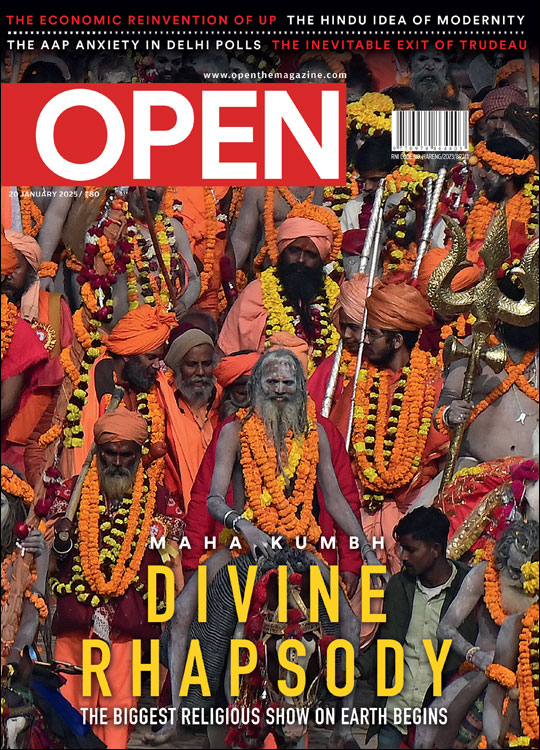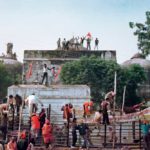A Vandalised Civilisation
Post Independence, in our collective zeal to present a politically correct version of history, we have ensured that Delhi’s and north India’s Hindu heritage remains hostage to a mix of distortions and apathy
/wp-content/uploads/2017/11/Vandalised1.jpg)
VS NAIPAUL WAS among the earliest to pronounce the widespread prevalence of Mughal-era structures throughout north India—many built on the ruins of earlier Hindu religious structures—as an indication of cultural vandalism in history. According to the writer, several of today’s celebrated examples of Mughal and Islamic architecture were a standing monument to wounds inflicted on Hindu Civilisation by Muslim conquerors. They were sym- bols of oppression, reminders of both the aggressive spread of Islamic rule in the region and the submissiveness of Hindu subjects. These medieval monuments, including the Taj Mahal, spoke to Naipaul of ‘personal plunder and a country with infinite capacity for being plundered’. Their presence still rankled, these signifiers of Hindu Civilisation’s failure to fight back and assert its identity.
This was the leitmotif that ran through Naipaul’s non-fiction works, from An Area of Darkness onwards. In this 1964 book, he wrote that the remains of historic Hindu religious structures in North India spoke of ‘waste and failure’ among the majority, with Islamic aggression still taunting Hindu gentility for it on the architectural landscape of modern India.
In April this year, Narendra Modi became India’s first Prime Minister in decades to take a visiting dignitary to a Hindu temple, when Australia’s Prime Minister Malcolm Turnbull came to Delhi. Keen to share insights of Hindu religion and philosophy, Modi accompanied his Australian counterpart to the Akshardham Temple in the capital. In the shadow of the grand structure—for which land was allotted on the eastern bank of the Yamuna by the Government during former Prime Minister Atal Bihari Vajpayee’s tenure—Turnbull stood impressed with the style, sweep and architecture of the Swaminarayan temple.
Until the early 1970s, it was the Lakshmi Narayan Mandir— popularly known as Birla Mandir, built by the industrialist family in the 1930s and inaugurated by Mahatma Gandhi—that used to be on the official itinerary of every foreign dignitary on a visit to Delhi. However, by the late 70s, temple visits had become a no-no in the routines of international diplomacy, and attention shifted to monuments of the Turko-Afghan or Mughal period.
India’s capital today is home to not a single ancient or historical structure of Hindu religious origin. The visitor circuit in the capital’s proximity thus includes the Taj Mahal in Agra (and often the Mughal fort there as well) and the Tomb of Sheikh Salim Chishti and Buland Darwaza (built by Akbar in 1576 CE to commemorate his victory over Gujarat) in Fatehpur Sikri, apart from the Qutub Minar, Red Fort, Humayun’s Tomb and sometimes the dargah of Hazrat Nizamuddin Aulia in Delhi. The Lakshmi Narayan temple and the Akshardham Mandir built in the 21st are the only introduction to the glorious history and splendid architecture of Hindu religious heritage in the capital. The defeat of Prithviraj Chauhan on the plains of what is now Haryana in 1192 CE by Mohammad Ghori began six centuries of Delhi’s domination by rulers who were Muslim and under whom no ancient Hindu religious monument was erected. On the available evidence, the capital area is believed to have had 15 settlements over two millennia between 3000 BCE and the 17th Century CE. According to oral tradition and legend, current-day Delhi was also the likely location of Indraprastha, capital of the Pandavas from the epic Mahabharata. Among the oldest inhabited cities in the world, Delhi has been built, destroyed and rebuilt by conquering hordes many times, and, although it is a mostly Hindu metropolis, little remains by way of pre-modern architecture to suggest so. Most of the small temple edifices on the sides of the capital’s roads are considered acts of illegal encroachment; and the boards proclaiming them as prachin (ancient) temples go back no further than a decade or so. That is a bitter irony in a city so ancient and repeatedly overlain that it is viewed by many as a city over a city over a city, with its essential Hindu cultural heritage all but wiped off.
The structures of worship that existed under the Tomara (736- 1160 CE) and Chauhan (1160-1206 CE) dynasties are believed to have been destroyed by subsequent invaders of Islamic persuasion. Today, the ruins of Lal Kot, capital of the last Hindu kingdom, lie hidden behind a commercial complex in Mehrauli. Built in 1052 CE by Anangpal, it was expanded and fortified in 1180 CE by Prithviraj Chauhan to defend his kingdom against invasion. At the time, the city was known as Qila Rai Pithora. Later, it would become the seat of the Mamluk (Slave) dynasty, whose buildings serve as the locality’s landmarks. The Qutub Minar, the 73-metre minaret that defined Delhi’s skyline for centuries after it was built some 800 years ago by that Turkic-Afghan dynasty’s Qutub- ud-din Aibak, stands next to the Quwwat-ul-Islam mosque, constructed around the same time on the site of 36 Hindu and Jain temples in existence before that. That idols of worship were smashed by iconoclastic warriors, and magnificent sculptures disfigured for use as building material for the city’s first mosque can be seen in the pillars at this site.
The wanton acts of vandalism and desecration by conquering hordes in evidence across north India is reminescent of the 2001 demolition—under orders of the then Taliban chief Mullah Muhammad Omar—of the globally-renowned Buddha statues at Bamiyan valley in central Afghanistan, 230 km northwest of Kabul. The 35- and 53-metres tall statues were truly stunning accomplishments, carved into the side of a cliff in classic Gandhara style about a millennium-and-a-half ago. They were blasted apart by dynamite, attracting global condemnation and drawing the Taliban into the spotlight for their gross religious intolerance.
Similar acts by medieval invaders, however, have not been viewed by all historians through the same prism of bigotry aimed at humiliating the conquered. Instead, the argument over this aspect of history has got sidetracked to whether claims of the count of Hindu shrines demolished by Islamic rulers are backed by evidence or have been overblown. Some contend that victors destroying shrines to deities that had state patronage under the defeated regime was a practice in medieval times even among warring Hindu kingdoms.
Today, contentions that play down the violence of the region’s history do not convince more than a few intellectuals and others with leftist leanings. Historians of the British Raj, too, mostly viewed north India’s medieval past as an unending story of pillage by Muslim rulers of a Hindu country, though they presented their own colonial influence as having had a civilising effect. In a 1999 interview, Naipaul asserted that Christian regimes did not vandalise India and Hindu heritage the way Islamic rulers did over the centuries. Naipaul observes that to truly experience the greatness of Hindu architecture from history, one has to travel across south India. To him, the ruins of the south symbolise the ‘continuity and flow of Hindu India, ever shrinking’.
WHILE THE SULTANS of Delhi were wrecking Hindu heritage in the north, the splendid temples built by the Chola, Chalukya, Hoysala and other ruling dynasties in the south have survived to tell the story of a glorious Hindu past. In 1975, visiting the ruins of the ancient Hindu Empire of Vijayanagara on the banks of the Tungabhadra river in Karnataka, Naipaul called it ‘a great centre of Hindu civilisation’ and ‘one of the greatest cities’ of the world in its time. His distress over its end is almost palpable in his 1977 book India: A Wounded Civilization. Today, the monuments at Hampi, embracing the ruins of Vijayanagara, capital of the eponymous empire, are also home to remnants of Dravidian temples and palaces that won the admiration of travellers between the 14th and 16th centuries.
That empire’s fall came not long after the Second Battle of Panipat in the north, which was fought in 1556 and marked the start of Mughal Emperor Akbar’s reign. His forces defeated those of the Suri dynasty’s Muhammad Adil Shah led by General Samrat Hem Chandra Vikramaditya, better known as Hemu. The general was struck by an arrow in the eye, and his army panicked. By some records, Hemu was decapitated and his torso was carried to Agra as part of the war spoils. It was in 1565, almost a decade after Akbar’s victory, that the Vijayanagara Empire crumbled in the south under the onslaught of an alliance of Muslim-ruled principalities around it. The plunder, Naipaul observes, went on for anything between five months and a whole year. Hampi today houses the renowned Virupaksha Temple and other monuments, all of which are on Unesco’s World Heritage List of historical sites.
In this narrative, the ferocity with which Muslim rulers enforced their control over their territories of conquest in the north ensured that religious structures of the Tomar-Chauhan period were taken down. There were fierce struggles among Turkic- Afghan warlords looking to seize power and no sultan of Delhi could let his army get complacent, but even phases of relative political stability did not result in more tolerance on their part towards the belief systems of the area’s earlier inhabitants.
While Hindus were largely free to pursue their religion in the privacy of their homes, the rulers did not allow any significant structure of a religious nature emerge under their watch that was not Islamic. The Mughal era, especially after Akbar, saw some shifts of state policy in favour of diversity, but the extent of these need not be exaggerated. Although the induction of Hindu advisors, administrators and army officers—as also the inter-marriage of Mughal princes and Rajput princesses—helped create a Muslim-Hindu pact of sorts that pre-empted any concerted anti-Hindu campaign, various restrictions stayed in place on practices that did not meet the approval of rulers. In general, with the ruling elite comprised largely of Muslims, there was little patronage of Hindus.
Independence Day TV viewers are familiar with visuals of the Gauri Shankar Mandir’s white summit and Jain Temple’s red shikhar across the Mughal-built Qila Mubarak, renamed the Red Fort by the British. The temples, however, looked nothing like this when Akbar’s grandson Shah Jahan founded the city of Shahjahanabad, of which the fort is a part. The Jain Temple, as seen today, came up in the early 19th century, in 1809 to be precise. Until the death of Shah Jahan’s successor Aurangzeb, this temple was a tiny place revered by Jain residents of the Dharampura locality. By the early 19th century, the Mughal Empire was in precipitous decline and weaklings on its throne with grandiose titles had little other than memories to remind them of their great past.
The Gauri Shankar Temple, on the other hand, came up in 1761, when Marathas had taken over Delhi and posed a serious threat to British ascendancy. A Maratha general built this temple and it stands as testimony to Maratha presence in the city for a short while until their defeat in the Third Battle of Panipat. This was fought between Afghan forces under the leadership of Ahmad Shah Abdali and Maratha forces under the Peshwas, who had established control across north India but suffered a defeat in the absence of support from Jats, Sikhs, Rajputs and the kingdom of Awadh, among others. All of them had reportedly been treated badly by Peshwa rulers at the beginning of their reign and are said to have been too cut up to offer support against Abdali’s army. The parallel decline of the Mughal Empire and the Peshwa defeat in this battle, which was drawn out over two months, marked the beginning of European colonial rule in India. After Maratha forces were driven out of Delhi, Hindu temples failed to come up under the capital’s new colonial masters.
Post Independence, in our collective zeal to present a politically correct version of history, we have ensured that Delhi’s—and north India’s—Hindu heritage remains hostage to a mix of distortions and apathy. History should be based on facts, not revised for political projects or harnessed for the sake of a narrative deemed ‘appropriate’ for mass consumption.
In the demolition of the Babri Masjid at Ayodhya in 1992 and its aftermath, Naipaul saw a resurgence of Hindu India, a resolve to rise above centuries of failure to fight back and assert itself, even signs of an energetic and compelling creativity.
If, after 70 years of independence and 25 years after the fall of that Mughal mosque, some citizens still cannot gain a broader perspective of that day’s events, they should perhaps question their view of history.

/wp-content/uploads/2025/01/Cover_Kumbh.jpg)












More Columns
Shivraj Singh Chouhan: Farmers’ Friend Rajeev Deshpande
Shreya’s Season Kaveree Bamzai
Vengeance Is Mine Kaveree Bamzai